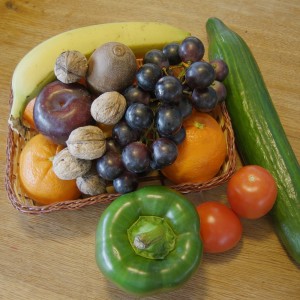
Including a rainbow of foods in your diet provides the balanced nutrition you need. It can also be a great way to get kids interested in fruits and vegetables!
Greens are the most important color to eat and they are the most under represented in the American diet. Greens are a good source of calcium, magnesium, iron, zinc, fiber, folic acid, chlorophyll, and Vitamins A, C, and E. Examples are: Kale, Collards, Swiss Chard, and Mustard Greens. Greens may offer some protection for diseases such as: cancer and heart disease.
Red foods are rich in phytochemicals e.g. lycopene, that reduce free radical damage. Examples are: red peppers, tomatoes, and pomegranates. Red foods may also lower cholesterol and improve lung function.
Orange foods are rich in carotenes and vitamin C. Examples are: oranges, carrots, orange peppers, and sweet potatoes. Orange foods are great for the eyes and may support night vision.
Yellow foods are a good source of vitamin C and B vitamins. Examples include: yellow squash, lemons, and yellow peppers. Yellow foods can help support the immune system.
White foods are a good source of many vitamins and minerals, including vitamin C and vitamin B6. Examples are: artichokes, fennel, parsnips, onions, garlic, and ginger. White foods such as onions, garlic, and ginger are natural antibiotics.
Blue and Purple foods a good source of antioxidants and B vitamins. Examples are: beets, eggplant, and purple cabbage. They may offer protection against certain cancers and heart disease.
Brown: although mushrooms are not technically a fruit or a vegetable, they are a great source of potassium and they also have some protein. Examples include: portabella mushrooms, shiitake mushrooms, and cremini mushrooms. Mushrooms may offer protection against cancer and heart disease.